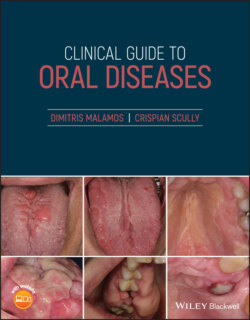Читать книгу Clinical Guide to Oral Diseases - Crispian Scully - Страница 49
Case 4.2
ОглавлениеFigure 4.2
CO: A 68‐year‐old man was referred for evaluation of his dental status and his rotten breath before the beginning of zoledronic acid treatment for his lung cancer spine metastases.
HPC: His bad breath was first noticed by his clinician one month ago when the patient visited him for back pain. His halitosis was constant, worse at mornings and night, and unrelated to his meals.
PMH: His medical history revealed hypertension and respiratory problems such as chronic bronchitis and a small cell carcinoma in the left lung diagnosed two years ago which was surgically removed (lobectomy), unsuccessfully, as recent metastasis into the spine had been shown. His smoking or drinking habits had stopped since the diagnosis of his cancer.
OE: Examination revealed a cachectic man with periodontitis with gingival pockets depth from 4 to 8 mm depth forming thus a suitable place for accumulation of excessive plaque and food debris on his remaining decayed teeth (Figure 4.2). No other oral lesions were detected. His breath was bad, rotten and repulsive. Severe pain and difficulties in posture were reported and according to his oncologist were related to his spine metastasis.
Q1 What is the origin of the bad breath?
1 Smoking
2 Poor oral hygiene
3 Spine metastasis
4 Antihypertensive drugs
5 Periodontitis
Answers:
1 No
2 Anaerobic bacteria are easily found in mature dental plaque, capable of disintegrating food debris and releasing a plethora of volatile molecules which are responsible for the patient's malodor.
3 No
4 No
5 No
Comments: Smoking can cause halitosis in some patients but is not the cause here, as this habit was stopped two years ago. Spine metastasis is associated with pain and moving difficulties and spinal cord decompression, but never with halitosis. Periodontitis and some antihypertensive drugs have been related to chronic halitosis, but cannot be the cause as his bad breath was recent and detected one month ago.
Q2 Which of the volatile gases is mainly responsible for the patient's halitosis?
1 Alcohol
2 Fatty acids
3 Amines
4 Sulfur compounds
5 Nicotine
Answers:
1 No
2 Volatile gases of fatty acids like butyric, valeric, and propionic acids are the result of anaerobic degradation of carbohydrates, which gives rise to oral malodor.
3 No
4 Sulfur compounds such as methyl mercaptan, hydrogen sulfide and methyl sulfide are responsible for his halitosis.
5 No
Comments: As the patient had stopped smoking or drinking for many months, his halitosis was not caused by the volatile gases released from alcohol metabolism and tobacco or its smoke‐related amines.
Q3 Which of the volatile substrates has/or have sulfur components that are involved with halitosis?
1 Cysteine
2 Methionine
3 Isoleukine
4 Histidine
5 Valine
Answers:
1 Cysteine is a non‐essential sulfur containing amino acid that is found in foods with high protein content like meat and eggs. Cystine and cysteine are metabolized under the presence of sulfhydrase positive bacteria, and release H2S, a very high volatile gas.
2 Methionine and cysteine are the two sulfur containing amino acids that play an important role in halitosis (cysteine > methionine).
3 No
4 No
5 No
Comments: All the other amino acids do not have sulfur components and do not participate in sulfur production during the degradation of food debris with bacteria.
